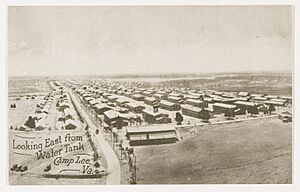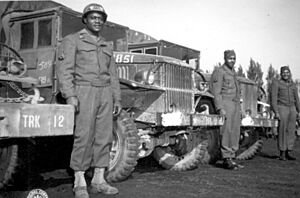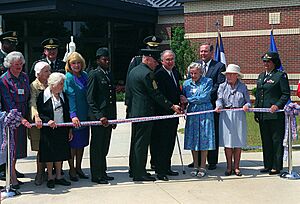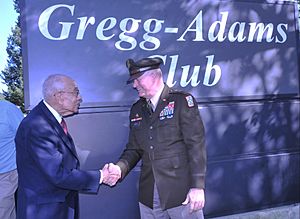Fort Gregg-Adams facts for kids
Quick facts for kids Fort Gregg-Adams |
|
|---|---|
| eponym: Lieutenant General Arthur J. Gregg and Lieutenant Colonel Charity Adams Earley | |
| Petersburg and Tri-cities Area | |
 
Shoulder sleeve insignia and emblems of units or agencies stationed at Fort Gregg-Adams
|
|
|
Location in Virginia
|
|
| Coordinates | 37°14′06″N 77°19′58″W / 37.23500°N 77.33278°W |
| Type | U.S. Army post |
| Site information | |
| Controlled by | U.S. Army |
| Site history | |
| Built | 1917 |
| In use | 1917–1924 1941–present |
| Garrison information | |
| Garrison | Combined Arms Support Command (CASCOM)/Sustainment Center of Excellence (SCoE) U.S. Army Quartermaster School U.S. Army Ordnance School U.S. Army Transportation School Army Sustainment University (ALU) Defense Commissary Agency (DeCA) |
Fort Gregg-Adams is a major United States Army base located in Prince George County, Virginia. It is a very important place for training soldiers in how to supply and support the Army. This includes teaching them about managing supplies, fixing equipment, and transporting goods.
The base is home to several key Army schools. These include the United States Army Combined Arms Support Command (CASCOM), the Sustainment Center of Excellence (SCoE), and schools for the Quartermaster, Ordnance, and Transportation branches. It also hosts the Army Sustainment University (ALU) and the U.S. Defense Commissary Agency (DeCA).
Fort Gregg-Adams also has two Army museums. These are the U.S. Army Quartermaster Museum and the U.S. Army Women's Museum. The Army's Ordnance Museum also moved its items here in 2009–2010. These items are now used by the United States Army Ordnance Training and Heritage Center.
The base was first called Camp Lee in 1917. It was named after Confederate General Robert E. Lee. In 2022, a special commission suggested changing the name. They proposed Fort Gregg-Adams, honoring Lieutenant General Arthur J. Gregg and Lieutenant Colonel Charity Adams Earley. This change was approved and happened on April 27, 2023.
Fort Gregg-Adams is also a census-designated place (CDP). In 2020, about 9,874 people lived there. This was almost three times more than in 2010.
Contents
- History of Fort Gregg-Adams
- Geography and Climate
- Current Units at Fort Gregg-Adams
- Images for kids
- See also
History of Fort Gregg-Adams
World War I: Camp Lee's Beginnings
Camp Lee was first set up in 1917. This was just 18 days after the United States declared war on Germany. It started as a camp for state soldiers and then became a training camp for a whole division.
The 80th Division, also known as the Blue Ridge Division, trained here. Soldiers from Pennsylvania, Virginia, and West Virginia made up this division. They trained at Camp Lee starting in August 1917.
Soon, Camp Lee became one of Virginia's largest "cities." More than 60,000 soldiers trained here for World War I. They then went to fight in France and Germany. The camp had a large hospital on 58 acres. In 1918, the Spanish flu epidemic hit the camp. About 10,000 soldiers got sick, and nearly 700 died in just a few weeks.
Construction began in June 1917. Within two months, about 14,000 men were at the base. The camp was home to the 155th Depot Brigade. These brigades welcomed new soldiers and draftees. They gave them uniforms, equipment, and basic training. They also helped soldiers return home and leave the Army after the war. When building finished, the camp could hold 60,335 men.
Camp Lee was still active in 1920. The 1920 US Census showed many soldiers living there. After World War I, Virginia took over Camp Lee. It became a game preserve. Parts of the land later became part of the Petersburg National Battlefield. In 1921, the camp officially closed. Most buildings were torn down, except for one called the “White House.” This building was the 80th Division Headquarters during the war. It later became known as the “Davis House.”
World War II: A New Camp Lee
In October 1940, the War Department decided to build another Camp Lee. It was built quickly on the same site as the first camp. Construction was still going on when the Quartermaster Replacement Training Center (QMRTC) opened in February 1941. The number of soldiers grew to 25,000 in 1942 and reached 35,000 in 1944.
While the QMRTC was starting, the Quartermaster School moved to Camp Lee. In October 1941, the school moved from Philadelphia. It began training officers and non-commissioned officers in military supply and service. They offered many courses, including Officer Candidate School. By the end of 1941, Camp Lee was the main center for Quartermaster training. It stayed that way throughout the war.
During the war, Camp Lee's population grew rapidly. It became the third largest "city" in Virginia. More than 50,000 officers attended Quartermaster Officer Candidate School. Over 300,000 Quartermaster soldiers trained here during the war. The base also had a large hospital that could hold over 2,000 patients. Camp Lee was known as one of the most effective military bases in the country.
Post–World War II Era: Becoming a Permanent Base

In 1946, the War Department announced that Camp Lee would stay open. It would be the main center for Quartermaster training in the Army. The Quartermaster School continued its work. In 1947, the Adjutant General's School also moved here until 1951.
The Women's Army Corps also set up its main training center here from 1948 to 1954. In 1948, the first permanent brick building was built. This was the Post Theater, now called the Powhatan Beaty Theater.
Cold War Era Growth (1950 – 1965)
During the Korean War (1950-1953), many thousands of soldiers came to Fort Lee. They received training in logistics (how to manage supplies and equipment) before going overseas. In 1950, the base was officially recognized as permanent and was renamed Fort Lee.
After the Korean War, the base began a big building program. They started replacing temporary wooden buildings with permanent ones.
Air Force SAGE Site
In 1956, the Fort Lee Air Force Station was chosen for a special Air Force site. This was for the Semi Automatic Ground Environment (SAGE) system. A large, four-story building was built to hold powerful computers. These computers could get information from sensors on the East Coast. They would then provide details about any incoming Soviet air threats.
The SAGE Direction Center (DC-04) became active in February 1959. It helped oversee air defense operations. Its job was to train and keep tactical units ready. These units flew jet interceptor aircraft like the F-101 and F-106. They also used interceptor missiles like the CIM-10 Bomarc. They practiced missions and exercises to simulate stopping enemy aircraft.
First Permanent Buildings
The 1950s and 1960s saw many updates at Fort Lee. The temporary wooden barracks and training areas were replaced. New, permanent brick and cinderblock buildings were constructed. New multi-story barracks were built in the mid-1950s. Whole communities of homes for permanent staff were also added.
In May 1961, the new three-story Quartermaster School, Mifflin Hall, was opened. Kenner Army Hospital opened in 1962. It replaced the older World War II facility. The U.S. Army Quartermaster Museum opened in 1963. Modernization has continued ever since.
Quartermaster Training Center
The Quartermaster Training Center was created to oversee training for Quartermaster personnel. This led to more intense training activities. Courses that were taught elsewhere were moved to the Quartermaster School.
In 1962, Fort Lee became a Class 1 military base. The Quartermaster School became part of the Continental Army Command school system. It was also chosen to be the home of the Quartermaster Corps.
Vietnam and Post-Vietnam (1965 – 1990)
After 1965, the Vietnam War led to a big need for more Quartermaster soldiers. Fort Lee worked very hard to meet this need. For a while, the school ran three shifts, with training happening around the clock. A Quartermaster Officer Candidate School reopened in 1966. This was the first time since World War II. A pretend Vietnamese "village" was built on base. This helped trainees learn about guerrilla tactics and fighting conditions in Southeast Asia.
In July 1973, Fort Lee came under the control of the U.S. Army Training and Doctrine Command. Also, the U.S. Army Logistics Center was created in 1973. Its job was to bring together the Quartermaster, Transportation, Ordnance, and Missile and Munitions Centers and Schools. These are the traditional Combat Service Support branches.
In 1990, the base was reorganized again. The U.S. Army Logistics Center was renamed the U.S. Army Combined Arms Support Command (CASCOM). The CASCOM Commander also became the Fort Lee Installation Commander.
Recent History (2000s – 2020s)
In May 2001, the United States Army Women's Museum (AWM) moved to Fort Lee. It has over 13,000 square feet of space. It uses thousands of items to tell the long history of women in the Army. The base also hosted many other groups. These included the Army Logistics Management Center (ALMC) and the Defense Commissary Agency (DECA).
Base Realignment and Closure (BRAC) 2005
In 2005, the Base Realignment and Closure (BRAC) law was passed. One of its goals was to move several important Army groups to Fort Gregg-Adams. This included the United States Army Ordnance Corps headquarters. Also, the United States Army Ordnance Munitions and Electronic Maintenance School (OMMS) moved from Aberdeen Proving Ground. The United States Army Ordnance Munitions and Electronic Maintenance School (OMEMS) moved from Redstone Arsenal, Alabama. The Ordnance Museum also moved here by September 2011. The transfer of museum items began in August 2009. The U.S. Army Transportation Center and School also moved from Fort Eustis to Fort Gregg-Adams.
A major part of BRAC was building the Sustainment Center of Excellence (SCoE) headquarters. In 2007, a groundbreaking ceremony took place for the new building. It took 18 months to build and opened in January 2009. It now houses the Combined Arms Support Command. It also holds the command groups for the Quartermaster, Ordnance, and Transportation Corps. On July 30, 2010, the new building was officially named “Mifflin Hall.”
A new U.S. Army Logistics University was also built. It opened in July 2009. This university brings together training for all Army sustainment branches. It trains non-commissioned officers, warrant officers, commissioned officers, and government civilians. The large building is 400,000 square feet. It offers over 200 courses and trains about 2,300 students daily. Its International Studies program welcomes military personnel from more than 30 allied countries.
Fort Gregg-Adams is the first Army post to have a full-size statue honoring women in the Army. The statue was revealed in 2013.
The base became the main center for logistics and sustainment for the U.S. Army. After the BRAC construction projects finished, the base gained 6.5 million square feet of new buildings. About 70,000 troops now train here each year. In 2017, the post celebrated its 100th birthday. The celebration was called "A Century of Support to the Nation."
2020s: Operation Allies Refuge and Name Change
In July 2021, the base helped with Operation Allies Refuge. This mission helped Afghan evacuees start new lives in the United States. This happened after the war in Afghanistan ended. Base leaders formed "Task Force Eagle." They supported this mission for four months. The Department of Defense helped transport and house Afghan evacuees. They also provided medical checks and general support at military bases across the country.
The goal was to help Afghans and their families. They needed to finish immigration paperwork and get medical care. Fort Gregg-Adams (then Fort Lee) was the first of eight bases chosen to help. It provided temporary housing for over 3,000 Afghans. The mission ended in November 2021.
Renamed to Fort Gregg-Adams
On April 27, 2023, Fort Lee was officially renamed Fort Gregg-Adams. It is named after two African American officers: Lieutenant General Arthur J. Gregg and Lieutenant Colonel Charity Adams. This name change was suggested by a special commission. They wanted to rename military sites that were linked to the Confederate States of America. This renaming is special because it is the first time since 1900 that a fort has been named after a living service member.
Other parts of the base have also been renamed. For example, Lee Avenue is now Gregg Avenue. The Gregg-Adams Officers' Club was also renamed. In 1950, Lieutenant General Arthur Gregg, when he was a young Second Lieutenant, was not allowed into this club. This was because of discrimination and segregation against African American soldiers at that time. This happened even though President Harry S. Truman had signed an order against it two years earlier.
Geography and Climate
Fort Gregg-Adams covers about 8.4 square miles (21.6 km2) of land. The climate here has hot, humid summers. Winters are generally mild to cool. It has a humid subtropical climate.
Current Units at Fort Gregg-Adams
- Kenner Army Health Clinic
- 54th Quartermaster Battalion
- 111th Quartermaster Battalion
- 94th Training Division
- 345th Training Squadron (USAF)
- 262 Quartermaster Battalion
- 266 Quartermaster Battalion
Images for kids
-
Cpl. William R. Davidson of Philadelphia, Pa., 114th Graves Registration Co., Quartermaster Corps, fills out a Form 52B, giving information regarding a deceased American soldier at the UN Cemetery at Taegu, Korea. At right are (l-r) marker (cross), unidentified soldier marker (triangular), and small bottle containing Form 1042 which is buried with the soldier, U.S. Army photograph, 23 January 1951
See also
 In Spanish: Fort Gregg-Adams para niños
In Spanish: Fort Gregg-Adams para niños
















